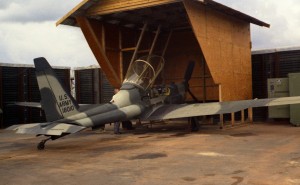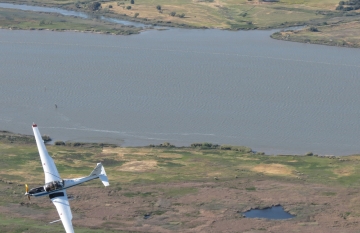YO-3A “Quiet Star” Silent Stealth Airplane
- Introduction
- Specifications
- Power Train
- Asymmetrical Exhaust System
- Operating Characteristics
- Mission Equipment
- History
- Photo Gallery
YO-3A “Quiet Star” Silent Stealth Airplane
The Lockheed Missiles & Space Company model YO-3A has been highly modified from a Schweizer SGS-232 glider. The aircraft, which is specifically designed for night covert observation, is characterized by a relatively large wingspan and large canopy area. The pilot and observer are seated in tandem, with the observer forward. It is a single-engine, low-wing monoplane of semi-monocoque construction. The YO-3A is all-metal except for the following: ailerons and rudder are of fabric. The engine cowl, aft canopy, exhaust shroud, wing-root fairings and wheel-well fairings are fiberglass. The canopy is acrylic (the largest single blown canopy on an aircraft at the time.) The propeller is wood and was designed for LMSC by Ole Fahlin. The tail wheel is steerable and releases to full swivel after 30 degrees of tailwheel turn.
The elements that make the YO-3A silent: (a.) clean airframe, (b.) muffled engine, (c.) quiet, asymmetrical exhaust system, (d.) 100 inch belt driven wooden propeller with a propeller tip speed of 800 RPM, (e.) operating at 1500 feet AGL at 70 knots IAS and (f.) ambient or background noise. The YO-3A operating at night without running lights, at mission altitude and speed, is also virtually invisible. Aboard the Quiet Star on the night-time surveillance missions the pilot and observer operated as a close team while looking for enemy activity. Typical missions included area surveillance, locating supply and reinforcement routes and enemy base camp locations, U.S. and ARVN camp perimeter surveillance, friendly troops under attack, and POW movements. On one occasion, the YO-3A group was called on to assist in a multi service operation that resulted in the sinking of an armed enemy surface ship that was attempting to deliver munitions and supplies to Viet Cong units.
The observer, sitting in front of the pilot, used a sophisticated night vision aerial periscope (NVAP) developed especially for the YO-3A by Electro Optical Systems. The NVAP was aided on dark nights by an infrared illuminator (IRI)that was also covert and invisible to the human eye which significantly aided in interpreting enemy activity. The IRI could also be used as a target designator, similar to current laser targeting devices, to provide pinpoint target designation to compatibly equipped Army assets, which provided first round hits from long range on a precise target. During the deployment of the YO-3A, the group’s crews worked with Army and ARVN artillery; Army, Navy, and Marine Corps helicopter gunships and fixed-wing TACAIR, naval gunfire, and numerous ground unit actions. On at least one occasion, a YO-3A crew coordinated a night helicopter airborne assault against an enemy position, providing accurate information to the assault commander on the exact location and movement of the enemy, and directed blocking artillery that enabled the assault force to engage the enemy effectively.
The typical mission profile was to fly the YO-3A at 1,000 feet above ground level (agl), but after gaining considerable experience, pilots found they could fly undetected at much lower levels. Several pilots flew multiple missions at 100 to 200 feet agl without being detected by enemy troops below. The aircraft was so quiet that he and the other YO-3A pilots were never effectively targeted by the enemy.
Specifications
- Wingspan
- 57 feet
- Length
- 29 feet 4 inches
- Aspect ratio
- 1:7 at 80 kts IAS
- Wing Area
- 213.1 square feet
- Aileron area
- 14.74 square feet
- Stabilator area
- 22.98 square feet
- Vertical fin area
- 13.47 square feet
- Ruder area
- 7.23 square feet
- Wing incidence at root
- +1.5 degrees
- Stabilator incidence
- -2.5 degrees (at neutral position)
- Maximum gross weight
- 3800 pounds (three-bladed propeller)
- G-limit
- +3.8 at 3800 pounds (spoilers closed)
- +2.2 at 3800 pounds (spoilers open)
- -1.5 at 3800 pounds (spoilers open or closed)
Power Train
The aircraft is powered by a six-cylinder, horizontally opposed, air cooled, fuel injection, Continental Model No. I0-360D engine. At standard seal level, maximum takeoff horsepower rating is 210 at 2800 RPM. The engine is coupled to the propeller drive system through a 12-sheave, 12 belt pulley-drive system, with an engine to propeller reduction ration of 3.33:1. The three bladed propeller is a laminated wood , constant-speed propeller, 100 inches in diameter. The three-bladed propeller replaced the 6 bladed ground-adjustable-pitch 6 blade propeller ion 17 March 1971. The engine cowling and firewall is lined with heat resilient, acoustical padding (fiberglass material) to dampen and contain engine noise.
Asymmetrical Exhaust System
The exhaust system is designed to collect exhaust gas from the cylinders, direct it overboard along the right side of the fuselage, AND EXPEL IT NEAR THE ADFT END OF THE FUSELAGE. This is done by means of a crossover exhaust pipe from the left bank of cylinder to the right side of the engine compartment (looking towards the propeller from the cockpit) where it joins the right bank exhaust pipe and exists the lower right side of the engine compartment. It then moves through an acoustical fairing into a dissipating and resonating mufflers and continues through the acoustical fairing to the aft end of the fuselage.
Operating Characteristics
- Ground turning radius
- 33 feet 11 inches
- Take off speed
- 60 knots IAS
- Take off roll
(three-bladed propeller) - 1720 feet at +15 degrees C.
- 2210 +35 degrees C at sea level
- At 1000 feet, 1960 feet and 2500 feet
- At 2500 feet, 2260 feet and 3050 feet
- Landing speed
- 63 knots
- Landing roll
- 1100 feet
- Rate of climb
(at 79 knots IAS) - Sea level—615 FPM
- 2500 feet—535 FPM
- Stall speed level flight
- 56 knots IAS
- Maximum continuous cruise
- 90 knots IAS
- Low noise cruse
- 70 knots IAS
(The above information is only for reference purposes. Pilots should not rely on this information and should use LMSC YO-3A operators manual.)
Mission Equipment
General
The integrated mission equipment installed in the YO-3A consists of the Night Vision Aerial Periscope (NVAP,) Laser Target Designator (LTD.) and Infrared Illuminator/Designator (IRI/IRD.) This equipment was designed to provide the YO-3A aircraft with the capability for night covert airborne surveillance, target acquisition, infrared target illumination, and laser target designation. Equipment design includes capabilities for location, identification, and designation of targets under conditions of ambient skylight, starlight and moonlight illumination on the order of 10(-5) to 10(-2) foot –candles. The purpose of the IRI is to provide the observer with an optional capability of target contrast enhancement by supplementary infrared illumination.
NVAP
NVAP (Night Vision Aerial Periscope) is a monocular, image-intensifying, optical periscope system with range and eyepiece focusing, terrain-scanning capability, and controls for an association infrared illuminator (IRI) subsystem, synchronized (bore-sighted) to the center of the NVAP field of view. The NVAP optical system features an image de-rotation system that presents the observer with an erect, horizon-oriented image, independent of the azimuth angle. The subsystem eyepiece optical train provides four-power magnification and may be removed and stowed for flight-compartment access and safety. NVAP sensitive is such that a target of 100 percent contrast may be observed under scattered clouds with no moonlight.
Overall subsystem resolution is described by the manufacturer as sufficient to distinguish a man five feet tall, from an altitude of 1000 feet, at an elevation angle of -30 degrees. This equates to a circle 394 feet in diameter at an altitude of 1500 feet, or a 264 foot diameter at an altitude of 1000 feet. The observer can place the system’s field of view at any location beneath the aircraft and can scan the terrain below as the aircraft traverses the area or he can scan by manual directional control of the field of view, independent of the aircraft’s flight path. Scanning range is limited only by airframe interference. Manual scanning is controlled by manipulation of a control stick in the observer’s flight compartment. The hand controller transmits angular rate signals for azimuth and/or elevation change to the scan head. These signals are proportional in amplitude to the displacement of the hand controller from its center position. A sighting of interest is acquired by the observer and held in the view through manual displacement of the hand controller. The angular displacement of the NVAP in both azimuth and elevation is indicated on the dual azimuth/elevation (AZ/EL) indicators located in both the pilot’s and observer’s compartments.
IRI/IRD (Infrared illuminator/infrared designator)
The IRI/IRD consist of a lamp reflector and visible spectrum cutoff infrared filter. This equipment is mounted under the fuselage approximately 14 feet aft of the NVAP scan head. Because the lamp is synchronously articulated by the NVAP, no parallax correction is incorporated in the system. Two beam widths are available: 1.9 degrees for target designation, and a minimum of 4 degrees for target illumination. At 100 feet of altitude, the 1.9 degree beam projects a circle of illumination 33 feet in diameter on the ground and at 1500 feet altitude, a circle 50 feet in diameter. The 4 degree beam projects a circle of illumination 70 feet in diameter on the ground, at 1000 feet altitude, and 104 feet in diameter from 1500 feet of altitude. The output of this unit is within the spectral range of the NVAP and provides target illumination equivalent to that of a full moon.
LTD (Laser Target Designator)
The LTD is a solid state laser that operates at a high power level. The LTD is bore-sighted to the center NVAP optical system and is aligned to within approximately 0.5 degree of the NVAP reticle cross-hairs. The LTD beam is integrated into the NVAP equipment to follow the NVAP field of view in azimuth and elevation. It is used to mark targets for ordinance delivery by friendly aircraft equipped with appropriate sensing devices. The laser beam is outside of the visible spectrum, but may cause eye damage to a range of 40,000 feet. The use of the LTD is the option of the observer. Since the laser is undetectable through the NVAP, the laser reticle flashes at the selected pulse rate when the laser is fired. The purpose of the laser designator is to provide a means of covert target designation. A detector, called a “seeker,” with an appropriate display is installed in a UH-1 or AH-1G Cobra helicopter. The “seeker” installed in the armed aircraft is coupled to a visual display to present steering information to the pilot or copilot/gunner for bringing the weapon system to bear on the target being marked by the YO-3A laser designator. (NOTE: The YO-3A LTD was never used in Vietnam. The “seeker” and munitions were still in development for the UH-1 and AH-1G helicopters.)























































Pingback: Lockheed YO-3A Quiet Star – Silence Was It’s Only Protection – Aces Flying High